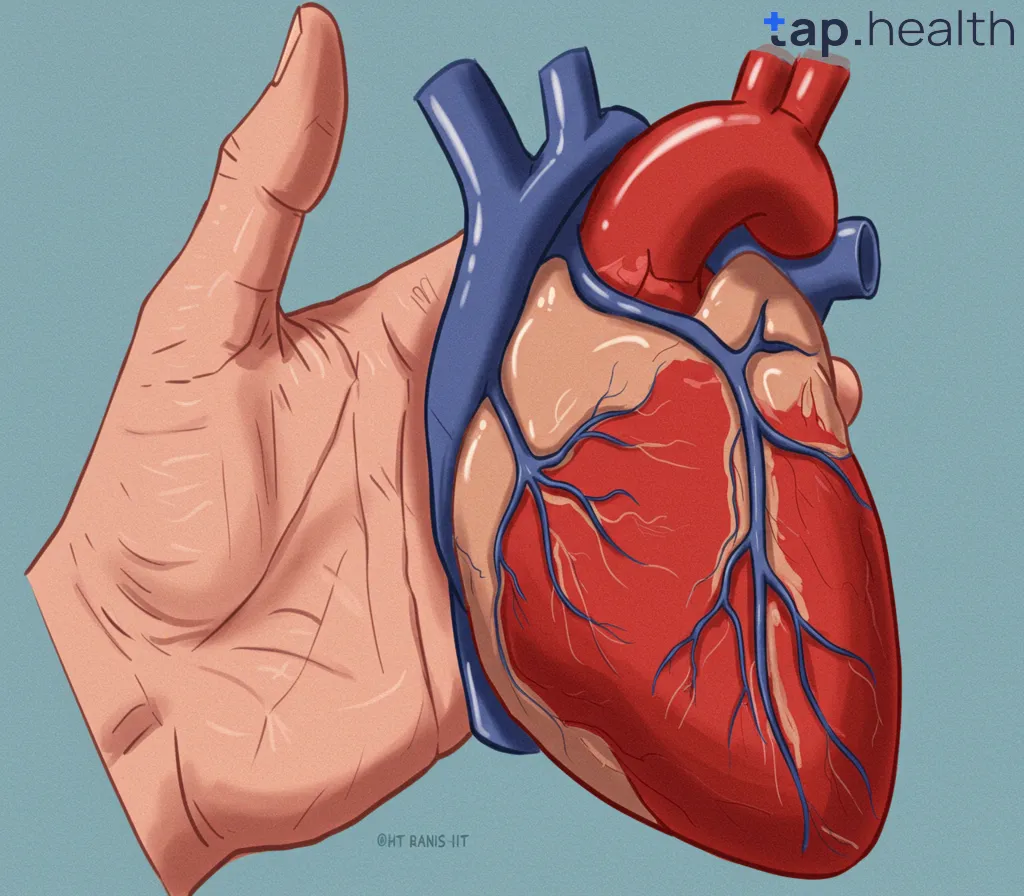The human heart is a vital organ that works tirelessly, pumping blood throughout the body to deliver oxygen and nutrients while removing waste. It’s made up of four chambers: two atria (upper chambers) and two ventricles (lower chambers). Each of these chambers plays a specific role in ensuring the heart’s proper function. But have you ever wondered which chamber of the heart has the thickest wall?
Understanding the structure of the heart and the role of each chamber is essential for grasping how blood flows through the body. In this article, we will explore the anatomy of the heart, focus on the chamber with the thickest wall, and discuss why this is important for the heart’s function.
What Are the Four Chambers of the Heart?
The heart consists of four chambers that work together to circulate blood efficiently. These chambers are divided into two atria and two ventricles:
- Right Atrium: This is the upper chamber on the right side of the heart. It receives deoxygenated blood from the body through the superior and inferior vena cava.
- Left Atrium: This is the upper chamber on the left side of the heart. It receives oxygenated blood from the lungs through the pulmonary veins.
- Right Ventricle: The lower chamber on the right side of the heart, which pumps deoxygenated blood to the lungs through the pulmonary arteries for oxygenation.
- Left Ventricle: The lower chamber on the left side of the heart, which pumps oxygenated blood to the entire body through the aorta.
While all chambers are crucial for proper blood circulation, the ventricles have the thickest walls compared to the atria because they are responsible for pumping blood over long distances.
Which Chamber Has the Thickest Wall?
The left ventricle has the thickest wall of all the heart’s chambers. This is because the left ventricle must pump oxygen-rich blood to the entire body, including organs, tissues, and muscles. To do this effectively, it needs more muscle mass to generate the necessary pressure for blood to reach every part of the body.
Why Does the Left Ventricle Have the Thickest Wall?
The left ventricle’s thick muscular wall is designed for strength. The heart works by contracting and relaxing to pump blood, and the ventricles perform the strongest contractions. Here’s why the left ventricle needs more muscle compared to other chambers:
- Greater Pressure Requirement: The left ventricle needs to generate high pressure to send blood through the aorta, which then branches off to supply blood to the entire body. The muscles in the left ventricle work harder to produce this force.
- Longer Distance: Blood pumped by the left ventricle has to travel a much longer distance compared to the blood pumped by the right ventricle. It needs to reach the entire body, including the extremities and organs like the kidneys and brain.
- Thicker Wall for Strength: The thicker muscle mass allows the left ventricle to generate enough force to push oxygenated blood to distant organs and tissues with enough pressure to overcome resistance in the arteries.
Anatomy of the Left Ventricle
The left ventricle’s anatomy is designed to support its high-function role. Let’s break down some key features of the left ventricle’s structure:
1. Thick Muscular Wall
The left ventricle’s wall is much thicker than that of the right ventricle because of its role in pumping blood to the entire body. This thick wall is made of myocardial tissue (heart muscle), which allows for strong contractions.
2. Large Chamber Size
The left ventricle has a larger cavity compared to the right ventricle. This larger space is necessary to hold the oxygenated blood that is being pumped into the systemic circulation.
3. Aortic Valve
At the base of the left ventricle is the aortic valve, which opens to allow blood to flow into the aorta. The aortic valve ensures that blood flows in the correct direction and doesn’t flow back into the left ventricle after it has been pumped.
4. Left Ventricular Hypertrophy
In some cases, the left ventricle may become thicker due to conditions like high blood pressure or heart disease. This is known as left ventricular hypertrophy, which can lead to heart complications if untreated.
Comparison of the Left and Right Ventricles
While both the left and right ventricles have important jobs, their structure differs significantly due to the different tasks they perform. Here’s how the left and right ventricles compare:
| Feature | Left Ventricle | Right Ventricle |
|---|---|---|
| Wall Thickness | Thick, muscular wall | Thinner, less muscular wall |
| Function | Pumps oxygenated blood to the body | Pumps deoxygenated blood to the lungs |
| Pressure | High pressure (stronger contraction) | Low pressure (weaker contraction) |
| Distance Traveled by Blood | Long distance (entire body) | Short distance (lungs) |
| Oxygenation | Oxygen-rich blood | Oxygen-poor blood |
Why Does the Right Ventricle Have a Thinner Wall?
The right ventricle has a thinner wall compared to the left ventricle because it pumps blood over a much shorter distance. The right ventricle sends deoxygenated blood to the lungs for oxygenation, which is a much shorter trip than the journey to the rest of the body.
- Lower Pressure Requirement: The right ventricle doesn’t need to generate as much pressure as the left ventricle. Blood is pumped to the lungs through the pulmonary arteries, and this system doesn’t have the same level of resistance as the systemic circulation.
- Less Muscle Mass Needed: Because of the lower pressure required, the right ventricle doesn’t need as thick a wall. Its role is focused on maintaining a steady, low-pressure flow of blood to the lungs.
The Role of the Atria in Blood Flow
While the ventricles handle the heavy lifting of pumping blood, the atria (the heart’s upper chambers) play an essential role in receiving blood and preparing it for the ventricles.
1. Right Atrium
The right atrium receives deoxygenated blood from the body through the superior and inferior vena cava. It then sends this blood to the right ventricle, which pumps it to the lungs for oxygenation.
2. Left Atrium
The left atrium receives oxygenated blood from the lungs via the pulmonary veins. It then sends this blood to the left ventricle, which pumps it to the rest of the body.
While the atria have thinner walls than the ventricles, they still play a critical role in filling the ventricles with blood and maintaining efficient blood flow.
How the Heart Pumps Blood: The Cardiac Cycle
To understand how the left ventricle and the rest of the heart function, it’s important to understand the cardiac cycle, which refers to the sequence of events that occur with each heartbeat.
1. Diastole (Relaxation Phase)
During diastole, the heart is relaxed, and blood flows into the atria. As the atria contract, blood is pushed into the ventricles, preparing the heart for the next beat.
2. Systole (Contraction Phase)
During systole, the ventricles contract. The left ventricle generates high pressure to pump oxygenated blood into the aorta, while the right ventricle generates lower pressure to pump blood into the lungs.
3. End-Diastolic Volume (EDV) and End-Systolic Volume (ESV)
These terms refer to the volume of blood in the ventricles at the end of diastole (EDV) and the volume left in the ventricles after contraction (ESV). The left ventricle’s thick wall helps it effectively push out a higher volume of blood (with more force), ensuring it meets the body’s demands.
Common Heart Conditions Affecting the Left Ventricle
Some heart conditions can affect the left ventricle, particularly if the heart is under increased strain or if there is damage to the heart tissue.
1. Left Ventricular Hypertrophy (LVH)
This condition occurs when the left ventricle thickens due to high blood pressure or heart disease. The extra muscle mass can make the heart less efficient and increase the risk of heart failure.
2. Heart Failure
Heart failure can occur when the left ventricle becomes weak and cannot pump enough blood to the body. This leads to symptoms such as shortness of breath, fatigue, and fluid retention.
3. Aortic Stenosis
Aortic stenosis is a condition in which the aortic valve becomes narrowed, forcing the left ventricle to work harder to pump blood through the valve. Over time, this increased workload can lead to left ventricular hypertrophy.
Frequently Asked Questions (FAQs) on Which Chamber of the Heart Has the Thickest Wall?
1. Which Chamber of the Heart Has the Thickest Wall?
The left ventricle has the thickest wall of all the heart’s chambers because it is responsible for pumping oxygenated blood to the entire body.
2. Why Does the Left Ventricle Have a Thicker Wall Than the Right Ventricle?
The left ventricle has a thicker wall because it needs to generate higher pressure to pump blood through the aorta to the entire body. The right ventricle only pumps blood to the lungs, which requires less pressure.
3. What Happens If the Left Ventricle Becomes Enlarged or Stiff?
Enlargement or stiffness of the left ventricle, such as in left ventricular hypertrophy, can make it harder for the heart to pump blood effectively, leading to heart failure or other cardiovascular complications.
4. What Is the Role of the Atria in Blood Flow?
The atria receive blood from the body (right atrium) and lungs (left atrium) and pump it into the ventricles. While their walls are thinner than the ventricles, they are essential for ensuring efficient blood flow.
5. How Does the Heart Pump Blood Throughout the Body?
The heart pumps blood in a coordinated sequence: the right atrium receives deoxygenated blood and sends it to the right ventricle, which pumps it to the lungs. The left atrium receives oxygenated blood from the lungs and sends it to the left ventricle, which pumps it to the entire body.
In conclusion, the left ventricle has the thickest wall of all the heart’s chambers because it has the important job of pumping oxygen-rich blood to the entire body. Its thick muscular wall allows it to generate the necessary pressure to send blood to distant organs and tissues. Understanding the heart’s anatomy and the role of each chamber is essential for appreciating how the heart functions to maintain life.



